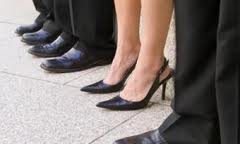 This blog is the first part of a two-part series. Look for Part II next week.
This blog is the first part of a two-part series. Look for Part II next week.
A front-page article titled Harvard Business School Case Study: Gender Equity in The New York Times on Sunday featured a two-year gender study that Harvard conducted on its own students.i For years, even women whose grades were on par with their male counterparts’ upon arrival fell behind once they were at Harvard. The school was also facing challenges in attracting and retaining female professors. So the idea was to see what curriculum, rules and social rituals were fostering men’s success over women’s—and then adjust them. What Harvard is learning is astonishing.
For example, half of students’ grades are based on participation. The research notes that to signal a desire to participate, women often slightly wave their hand, as if to say hello or they rest their elbow in the palm of the other hand. In contrast, men’s hands shoot straight up, signaling an enthusiastic desire to comment. So as part of the program, the school now provides hand-raising coaching.
“Women at Harvard did fine on tests. But they lagged badly in class participation, a highly subjective measure that made up 50 percent of each final mark,” writes Jodi Kantor of The New York Times. “Every year, the same hierarchy emerged early on: investment bank and hedge fund veterans, often men, sliced through equations while others—including many women—sat frozen or spoke tentatively. The deans expanded efforts like the hand-raising coaching and added stenographers in every class so professors would no longer rely on possibly biased memories of who had said what.”
These are just some of the many changes the school has implemented. By graduation 2013, more than 70 professors, students, and administrators agreed that Harvard had become a better school for female students, whose grades are now on the rise.
Introducing the second-generation gender bias
What Harvard is discovering—and attempting to address—is something researchers have coined a “second-generation gender bias.”ii As opposed to first-generation gender bias, which deals with legal cases around gender inequalities, second-generation gender bias comprises the cultural engagement and policies in workplaces and academia that impact men and women differently.
To foster women’s upward mobility, we often hear about the actions women should take and the quotas companies should instill. However, recent research is showing that we must also examine and sometimes adjust the context in which women are working, learning, and socializing.
Traditionally, organizations were structured to fit the lives of men. For example, many executives must relocate to assume senior-level positions. In traditional roles, men as breadwinners could easily uproot their spouses and families to make the change. However, the majority of women opt out of relocation since they face more challenging logistics in coordinating moves with husbands who may also be in professional careers.
Second-generation gender biases also include the personal biases we all hold in judging what we consider to be acceptable behaviors from each men and women. For instance, we tend to associate leadership with masculinity and being “nice” with femininity. This is where women get caught in the age-old double bind: When they’re assertive, they’re viewed as cold. If they’re nice, they’re viewed as not assertive enough. For years, women have struggled to find that perfect blend. While this is still important, maybe this struggle should be a shared one with women executives honing their leadership skills and everyone else honing their biases.
Stay tuned to next week’s blog where we’ll take a closer look at second-generation gender biases, and what both corporations and individuals can do to address them.
References
[i] Harvard Business School Case Study: Gender Equity. Nytimes.com. Available at: http://www.nytimes.com/2013/09/08/education/harvard-case-study-gender-equity.html?pagewanted=all&_r=0. Accessed September 8, 2013.
[ii] Women Rising: The Unseen Barriers. Hbr.org. Available at: http://hbr.org/2013/09/women-rising-the-unseen-barriers/ar/1. Accessed on September 4, 2013.





